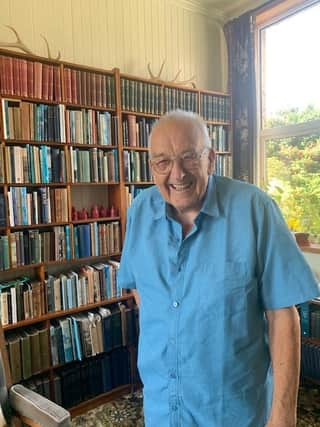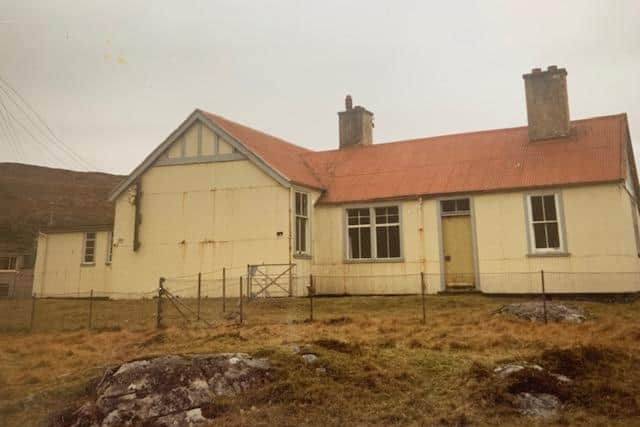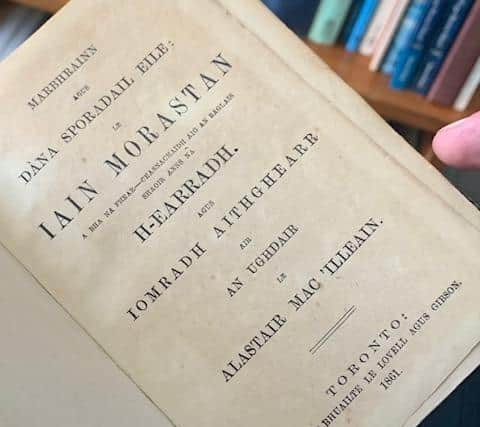Bill Lawson: safeguarding history for the future


The link is, of course, Bill Lawson whose contribution to the self-knowledge of island communities is legendary. While we’re talking numbers, Bill is 83 and first came to Harris more than 60 years ago as “a youngster with a rucksack who liked staying in inaccessible places, meeting the most inaccessible people”.
In the evenings, there was not a lot to talk about but their family stories and Bill became intrigued by the intellectual challenge of joining the dots. He quickly learned that the key to knowledge lay in “ the difference between hearing and listening”. Bill was a listener at a time when “nobody was really listening”.
Advertisement
Advertisement
He was born in Stirling before his dad became the County Assessor for Ayrshire. Family holidays were in Wester Ross but Bill was too tall a teenager for a 1950s car, so off he went on his own, striking out for Stornoway and soon to Harris.


Bill did a law degree at Glasgow University and practised for four years as a surveyor, while keeping touch with Harris and widening his researches. “If you are tracing family histories in Scarp, that soon takes you to Breanish, and so on”. Then he was offered a job setting up a course in Land Economics at Paisley College and a one year commitment turned into 17.
In 1981, the concept of the IDP emerged and Bill applied for the job of running it. He thinks he would have ended up in the islands one way or another but the IDP made it possible then.
His background was not in economic development. Instead, it was another way of doing what he had been doing for 20-odd years – visiting people’s houses and listening to their stories. What was needed in each place to make a difference? And then the conversation moved on to family history!
IDP DAYS IN 1980s


Advertisement
Advertisement
The IDP was a remarkable phenomenon, cooked up between the EEC and Scottish Office in Edinburgh as a pilot scheme in halting the decline of Europe’s most peripheral communities. The sum committed was £20 million over five years – £90 million at today’s prices - enough to make a real difference.
Bill recalls: “The official view I got from Edinburgh was that there was no chance of the money ever being spent. Crofters were only interested in subsidy. Our job was to make sure every crofter and fisherman knew what could be done under IDP and push them into making it happen”.
One of Bill’s favourite ports of call was the Buchanan home in Mangersta where he learned a lot about Uig family history. In his book, ‘Lewis in History and Legend’, he recalls another usefulness of this connection when some “top-brass civil servants from Edinburgh” were to attend an IDP meeting in Uig.
“I was rather worried that the meeting might follow the pattern of many in the islands, with nothing being said by the audience during the meeting and two hours spent in the car park afterwards”. Bill fixed it with my late brother-in-law, Murdanie, to make sure there was no shortage of dialogue and the top-brass departed, suitably impressed!
Advertisement
Advertisement
The IDP worked extraordinarily well. The general rule was that Bill dealt with Edinburgh while his lieutenants – Angus MacDonald from Barvas and Angus MacMillan from Bornish – did their work in communities. Their job was to encourage every household to believe that ideas and projects long talked about really could be delivered through the IDP.
Angus MacMillan points out: “The legacies are still with us. Fishery piers, processing, livestock marketing schemes, stock improvement schemes, the marts in Uist, there were 27 independently owned fish farms …
“If they’re looking for a blueprint post-Covid for regeneration, then the IDP provides it. As Bill says, we did go out to people’s houses. We did drum up business. But the ideas were there and people knew what could be done – which is still the case today”
Looking back on the IDP days, Bill says: “My job was to sell it in Edinburgh and the two Anguses’ job was to sell it to local people. They were so sure in Edinburgh that it would never be used, the terms of the programme were pretty much open-ended. When they came to do one for the Inner Isles, they had learned the lesson and the rules were so restrictive, hardly anyone could claim!
Advertisement
Advertisement
“There was a real buzz about the place. It was a chance for people to be in control of what they could do rather than being told by the Department office what they could and couldn’t do”. Another reason, perhaps, for the idea an IDP2 to be taken seriously as part of any “levelling-up” agenda.
NORTHTON SCHOOL
Job done with the IDP, Bill’s genealogical interest gradually became his means of livelihood. Northton School had closed in 1983 and lain empty for several years before Bill alighted upon it as a potential base. “It had two important characteristics – it was empty and it was dry, which was important for archive material but wasn’t that common in Harris”.
Gradually, the Northton operation expanded as family history requests came pouring in from around the world. However, the transformational event in Bill’s life was meeting his wife-to-be, Chris MacLeod, who was chair of the Comunn Eachdraidh in Point. They married in 1998 and formed a great partnership until Chris died four years ago.
“Chris was the business person and the media person,” says Bill. “She enjoyed and was very good at both”. The old school became their home as the business expanded around them. When a new exhibition centre, Seallam! was built close by, they gifted all the archive material to the charitable trust which continues to run it with Bill as “consultant genealogist”.
Advertisement
Advertisement
Bill gave Chris a unique wedding present – a croft history of her native village of Sheshader in Point. “It was meant to be a one-off,” he says. Over the intervening years, he has produced 96 books, mainly tracking the histories of crofting villages, as well as collaborating in many others. Currently, he is working on Scaladale, parts of Carloway and Daliburgh. There are plenty more to go.
Apart from listening and not just hearing, Bill attributes his exceptional abilities to a very good memory, which is still working extremely well, and also his interest in the social history which underpins the movements of people. “The land never changes,” he says, “The families do”.
Another early lesson was that received history is often inaccurate so it is essential to go back to basics. He quotes the example of Manish in the Bays of Harris which, when he started looking at it, was generally held to have been settled by people cleared from the fertile land of West Harris.
However, he found that did not fit the chronology. Manish was settled in the 1780s while the Harris clearances were in the 1820s. In fact, most of the Manish people came from Uist and Lewis to work on kelp. The result of this misunderstanding was that sight had been lost of those cleared from west Harris, who actually ended up in Cape Breton.
Advertisement
Advertisement
Nova Scotia and the Eastern Townships of Quebec have long since become natural extensions of Bill’s researches and he has written and lectured extensively on both. At present, he deals with around 150 “serious” research inquiries a year, mainly from North America, while many more are responded to by reference to published material.
There is no doubt about the biggest generator of information requests in recent years – the emergence of Donald Trump, with his Lewis mother. “You often didn’t know from the tenor of the letter if they did want to be related to him or didn’t want to be related to him”. The potential for business opportunism in less scrupulous hands is obvious!
Bill says they were “pestered for a few years” by evangelical churches in the Southern States who, once they knew there were Smiths in the Trump/MacLeod pedigree, were determined to find a link between the rogue President and the Smith Sisters, central figures in the Lewis Revival of 1949. “A load of rubbish,” says Bill.
He does point out though that “on the MacAulay side, Trump’s forebears were evicted out of Bernera to Point, so his family were victims of forced migration”. And that was before you get to his mother’s economic migration in the 1930s. File away for future use!
Advertisement
Advertisement
There was one inquiry from an American MacLeod who claimed to be related to Trump and whose own mother was a Pelosi. “I thought that could be interesting but then I found out that in the south of Italy, Pelosi is as common as Smith”!
Bill’s mission now is to safeguard information for the future. “A lot of my job at the Centre now is to get the stuff out of my head and make sure it is all cross-referenced. I’m conscious since Chris went that a lot of stuff is in my head and isn’t anywhere else”. A young researcher, Aonghais MacLean from Strond, has just joined the team to help that process.
The Business Manager at Seallam! is Stephen MacKinnon who has responsibility for the Trust’s future plans – expanding the existing Harris and St Kilda exhibitions, creating adventure and learning play areas, developing the reading room and research facilities. Another ambition, on land between the old school and Seallam!, is to create affordable accommodation for researchers.
Before Covid, Seallam! was attracting 10,000 visitors a year and the potential for expansion is clear. It is an island of quite rapid change, making it all the more important to learn from and about its past.
As Bill Lawson points out, “the land does not change” and his monumental life’s work will ensure the memory of generations long gone will live on in the families and communities they helped to shape.